Ohio is home to many exciting forms of wildlife, over rolling hills and crop-filled plains. In just about everyday life, we encounter spiders of one species or another—whether we see one on the side of our car mirrors or find one in the kitchen.
There are over 600 species of spider in Ohio, but here are the main types—we will discuss how to identify them and learn how they live in nature.

The 19 Spiders Found in Ohio
1. Orb Weaver
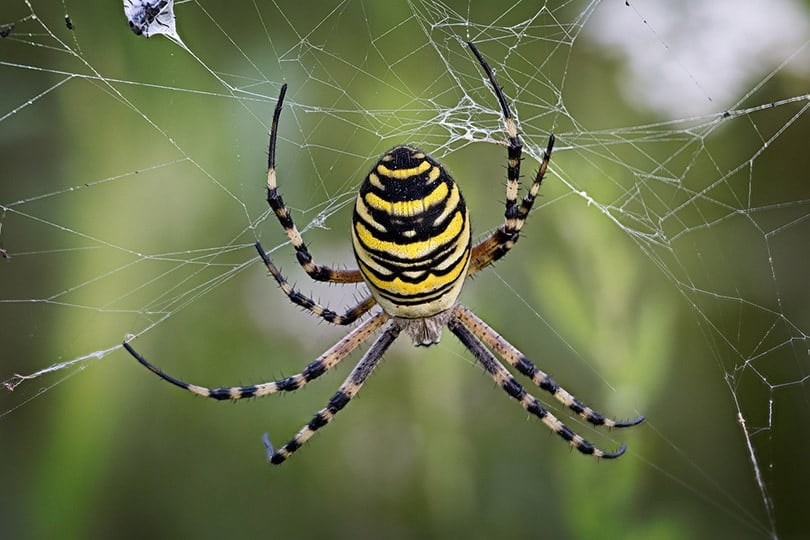
| Scientific Name: | Araneidae |
| Risk: | Peaceful, non-toxic |
| Area: | Tree branches, bushes, manufactured structures |
Orb weavers are actually a group of spiders, including the lined, arabesque, giant lichen, spotted, and marbled varieties. These spiders can look very different from one another, but most generally, they have bulbous bodies with medium, sturdy legs.
Orb weavers got their name from creating spiral webs, creating a circular design both intricate and lovely. These spiders are completely non-confrontational and totally harmless to humans and pets.
2. Garden Spider
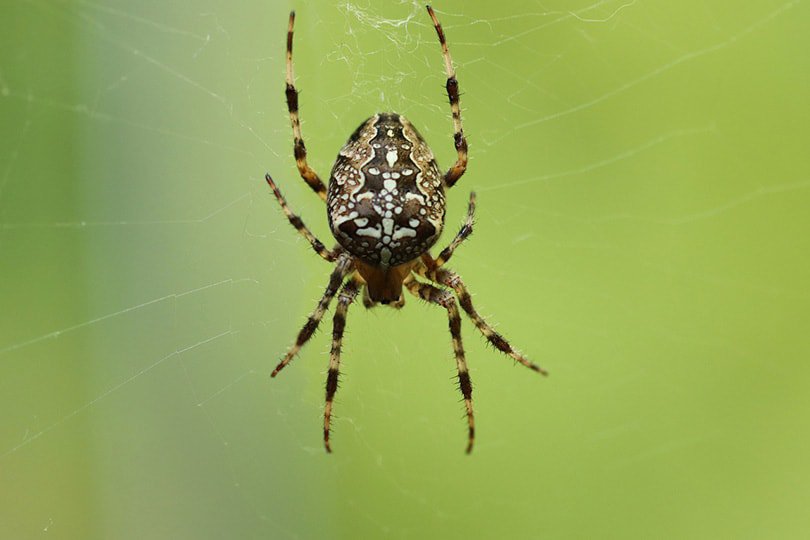
| Scientific Name: | Argiope aurantia |
| Risk: | Peaceful, non-toxic |
| Area: | Sunny, grassy land |
Garden spiders have some of the most stunningly impressive webs around. They seem to be made with perfection—spanning across (sometimes great) distances between plants. They love areas where bugs are prevalent, so your garden is an obvious choice to call home.
Garden spiders may look intimidating upon first glance, with their bold color and large size. However, these spiders are completely harmless—no danger at all to people.
3. Brown Recluse
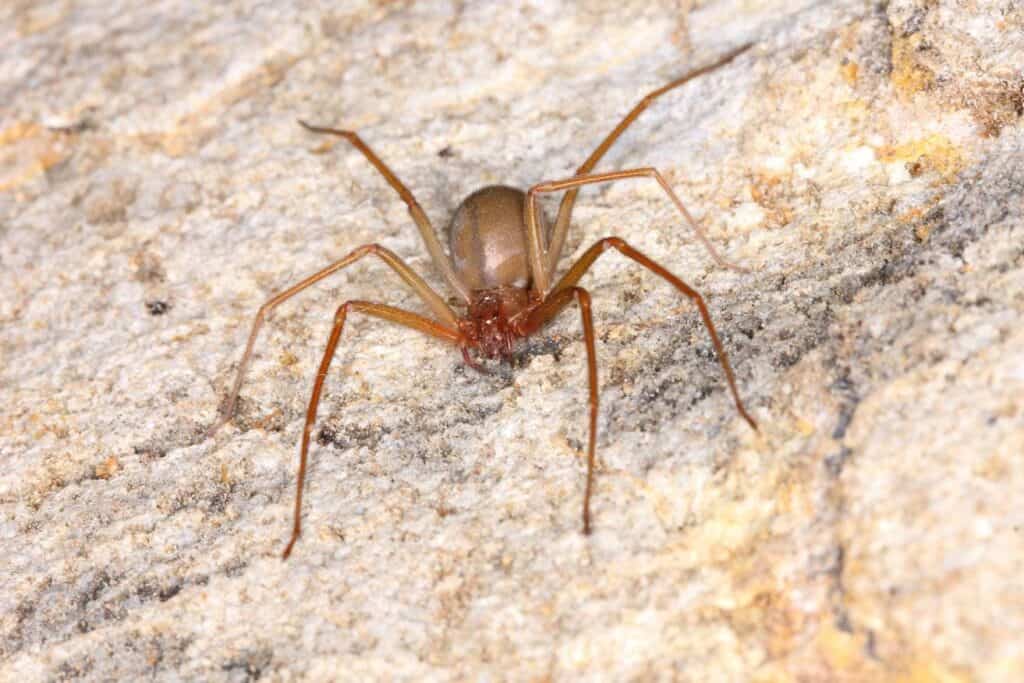
| Scientific Name: | Loxosceles reclusa |
| Risk: | Highly toxic, deadly |
| Area: | Moist, dark places |
If you live in Ohio, you’re probably familiar with the deadly danger of the brown recluse spider. These little arachnids have quite the reputation—with classic violin-shaped markings on their underbellies. However, they are more scared of you than you are of them.
Brown recluse spiders live in moist, damp areas—like cellars, crawl spaces, and dense forests. You probably won’t come face-to-face with one of these guys since they love staying out of sight. If you are bitten, you must seek medical attention right away.
4. Nursery Web Spider

| Scientific Name: | Pisauridae |
| Risk: | Peaceful, non-toxic |
| Area: | Dense plants, grasslands |
Nursery web spiders are widespread in Ohio, and they come in lots of different subtypes. At first glance, they might appear to be the wolf spider (which we will discuss later in the article.) However, these spiders are smaller—but the nursery webs have eight eyes all the same size.
These spiders are harmless, but they can bite—especially if they are guarding their egg sacs. Females get very frisky during the process until she successfully hatches their younglings.
5. Bold Jumper

| Scientific Name: | Pidippus audax |
| Risk: | Non-toxic |
| Area: | Farmland, forests, backyards |
The bold jumper is arguably one of the most adorable spider species of all. These little guys have very striking striped patterns, tiny furry legs, and big doe eyes. They are fast, too—living up to their name of ‘bold’ jumper with great success.
They can jump up to four times their body length—allowing for great range.
6. Eastern Parson Spider

| Scientific Name: | Herpyllus ecclesiasticus |
| Risk: | Mildly venomous |
| Area: | Brush piles, firewood |
Due to the old cravat style markings, the eastern parson spider is instantly recognizable. This ground spider doesn’t waste time spinning webs to catch prey. Instead, this ground spider takes off in a hurry to snatch up the latest bug unfortunate enough to get in their reach.
It’s pretty commonplace to see one of these guys in your home. If you do, don’t freak out. They might be fast, but they don’t damage humans (unless you have an allergy).
7. Black Widow
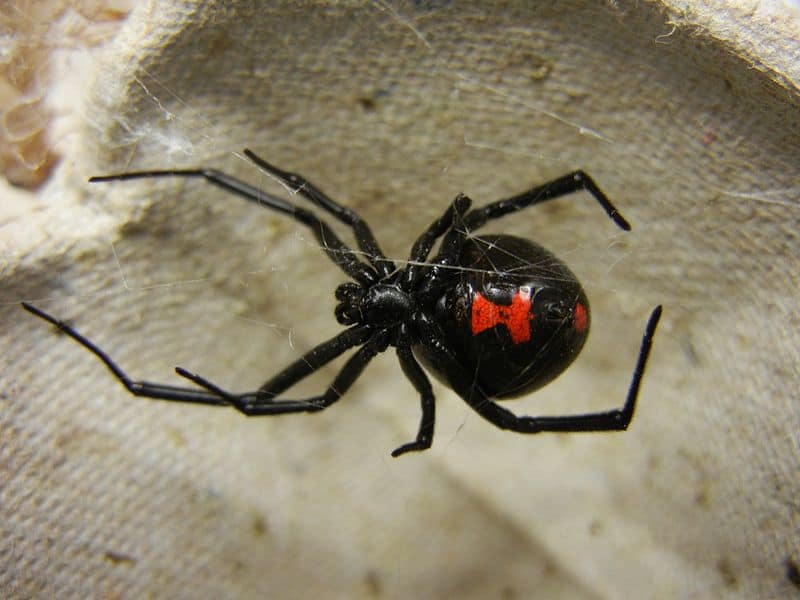
| Scientific Name: | Latrodectus |
| Risk: | Venomous |
| Area: | Dark places, cellars, garages |
The black widow spider is a stunning beauty, toting a bright red hourglass shape contrasting against shiny black. These spiders are as wicked as they sound, releasing some of the most toxic venoms of any spider in Ohio.
But these creatures are usually remarkably peaceful unless they are tampered with in some way. They tend to stay off to themselves and don’t wander into plain sight often, but they enjoy dark, secluded places like basements and garages.
8. False Black Widow Spider
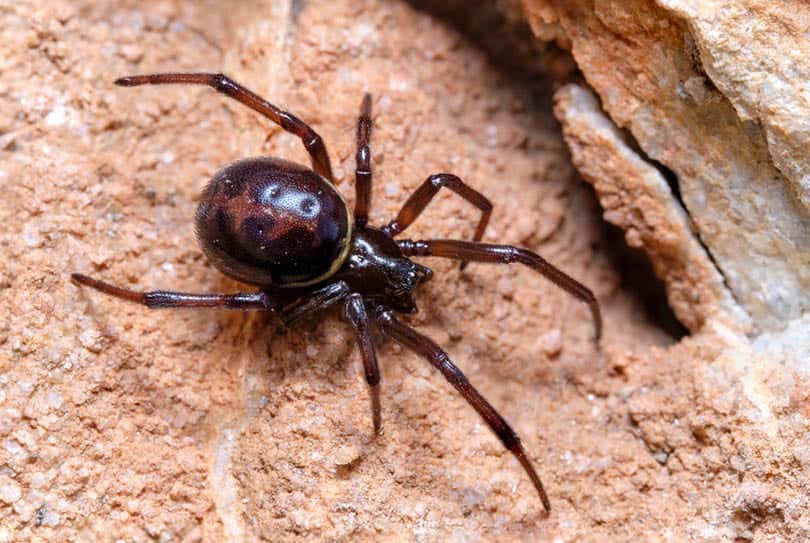
| Scientific Name: | Steatoda grossa |
| Risk: | Non-venomous |
| Area: | Trees, shrubs |
As you might assume, the false black widow spider is an arachnid that resembles the infamous black widow but isn’t the same at all. These spiders are totally harmless, whereas the black widow cousin is quite lethal.
If you look closely, a false black widow is brown with lighter intricate markings. They come in through windows but usually hang out in trees. These spiders do not make patterned webs like others, instead creating irregular cobweb patterns.
9. Hammock Spider
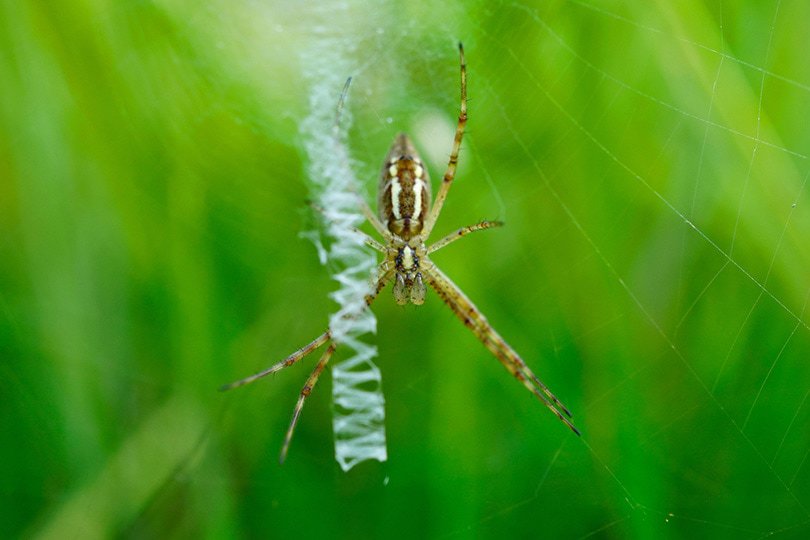
| Scientific Name: | Linyphia phrygiana |
| Risk: | Non-venomous |
| Area: | Trees and grasses |
The incredibly fascinating hammock spider is a genus of sheet weaver with a truly stunning sense of craftsmanship. It builds a cradling web, resembling the hammocks we love so much today. This design allows prey to snare in the trap opportunistically, which proves to have a very successful outcome.
The hammock spider is generally recognized by the distinct zig-zag pattern on its back.
10. American Grass Spider

| Scientific Name: | Agelenopsis spp |
| Risk: | Non-venomous, shy |
| Area: | Grass |
The American grass spider is a type of funnel weaver that builds a nest on ground level. These intricate designs lure prey in for a successful catch—and they build them with precision, using their tail end to spin the web in a funnel-like fashion.
These speedy predators are efficient, moving quickly to snatch prey that gets too close. You can recognize them by the classic black bands on their sides.
11. Deadly Ground Crab Spider

| Scientific Name: | Xysticus funestus |
| Risk: | Non-venomous, peaceful |
| Area: | Ground |
Contrary to its suggestive name, the deadly ground crab spider is totally harmless. It might look intimidating due to its vibrant orange color, but it cannot hurt pets or humans. Of course, natural prey, like ground insects, are another story—as these guys hunt efficiently on soil.
Crabs spiders have a crab-like shape, with wide bodies and curved legs. This body design is advantageous for eating opportunities. These little guys are super tiny, reaching approximately 3/16 of an inch.
12. Arrowhead Spider

| Scientific Name: | Verrucosa arenata |
| Risk: | Non-venomous |
| Area: | Bushes, thickets |
The arrowhead spider is a type of orb weaver that spins creations like an architect. The classic arrowhead shape on their back creates a triangle that points downward, showcasing their bulbous backside.
Surprisingly, only the females are classically recognizable. Males tend to be much smaller, lacking the same markings. You can find these guys, especially in the fall months, branching out between branches of saplings, trees, and woodland plants.
13. Long-Legged Sac Spider
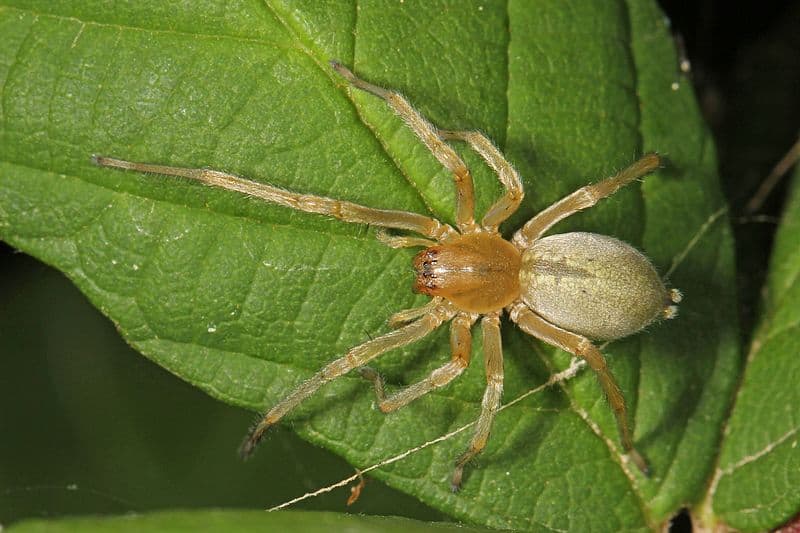
| Scientific Name: | Cheiracanthium mildei |
| Risk: | Slightly toxic |
| Area: | Manmade structures |
Long-legged sac spiders are very commonly found indoors—perhaps, one of the most noticeable spiders in your home. These spiders love making homes on ceiling corners to lounge. At night, they head out for the hunt, hurrying to capture rogue insects.
While they are beneficial to reduce other insects in the home, they have a dark side. Despite how much you may see them, try to avoid handling them since their bite is slightly toxic.
14. Triangulate Cobweb Spider
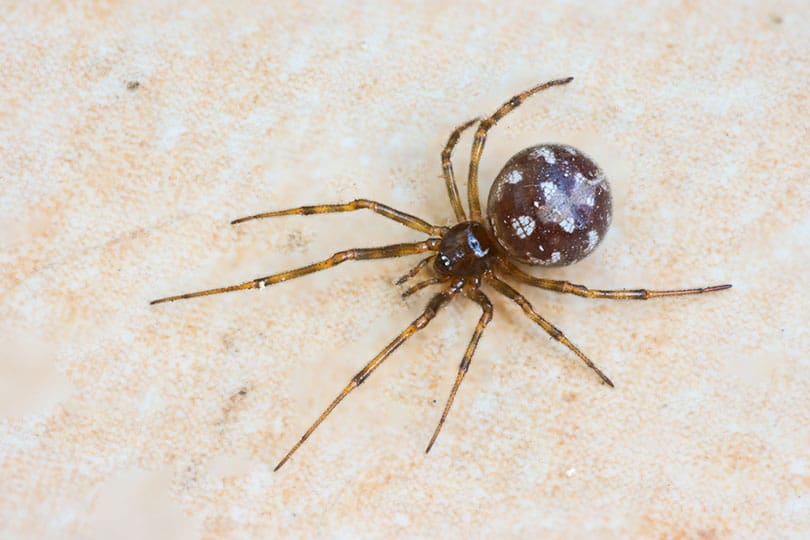
| Scientific Name: | Steatoda triangulosa |
| Risk: | Mildly venomous, non-aggressive |
| Area: | Dark spaces, manmade structures |
Triangulate cobweb spiders might look threatening with their bulbous bodies and spindly legs, but they’re really quite harmless. They prefer to mind their own business, safely tucked up in a corner somewhere.
These spiders adore manmade structures, quietly building webs in barns, basements, and garages. They spin webs to attract various insects and might even feed on smaller spiders if the situation presents itself.
15. Fishing Spider
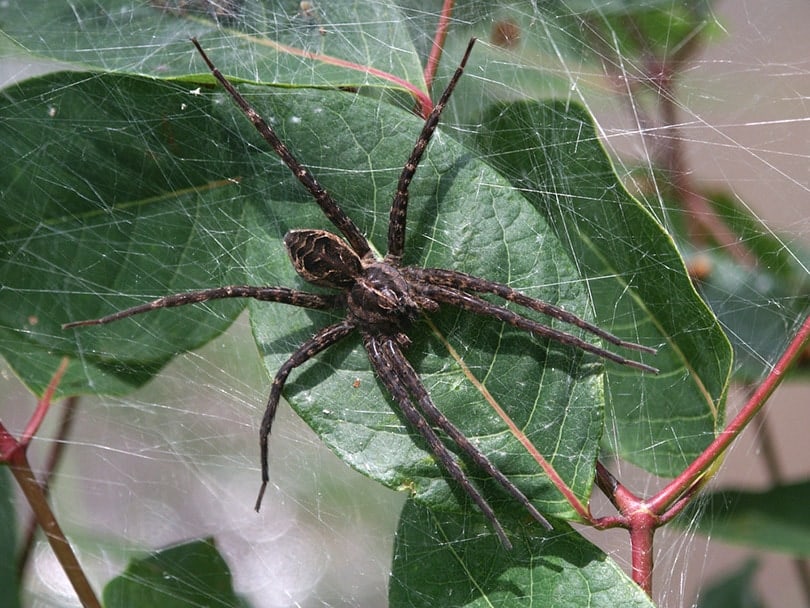
| Scientific Name: | Dolomedes spp |
| Risk: | Mildly venomous |
| Area: | Streams, rivers |
Members of the nursery web family, the fishing spider has a real love for the water. These spiders have impressive leg lengths of up to 3 inches (about the size of a medium hand minus the fingers). They spend most of their time on the water, floating along the top—which can be intimidating.
Even though these spiders might bite if they have no choice, they don’t go out of their way looking for trouble. They can also come off the water to venture on land, but they don’t do this as frequently as water-dwelling.
16. Funnel Weaver
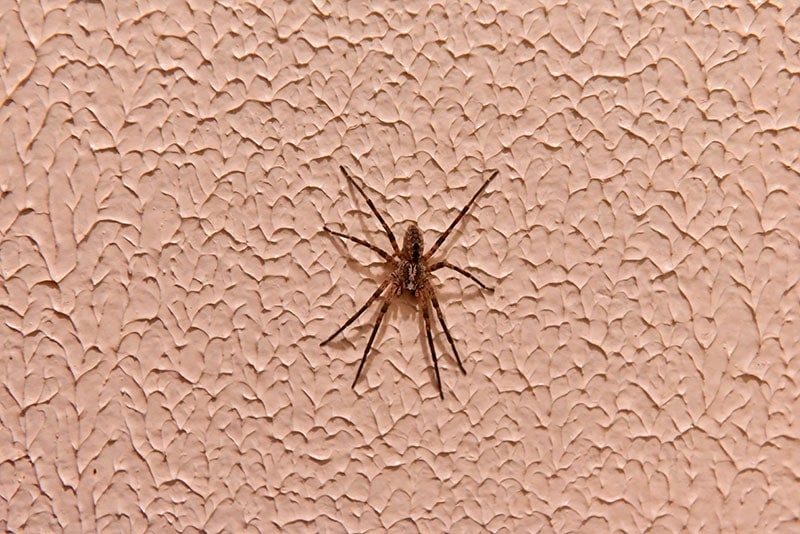
| Scientific Name: | Agelenidae |
| Risk: | Non-venomous |
| Area: | Grass, meadows |
Interestingly, funnel weavers do not build webs. Instead, they create impressively intricate tunnels on ground level to capture prey. You might see funnel weaver artworks on the bottom of your cabbage leaves or attached to your hostas.
The funnel weaver spiders aren’t one-size-fits-all. There are several spiders in this category that have the same basic structure and webbing habits.
17. Wolf Spider
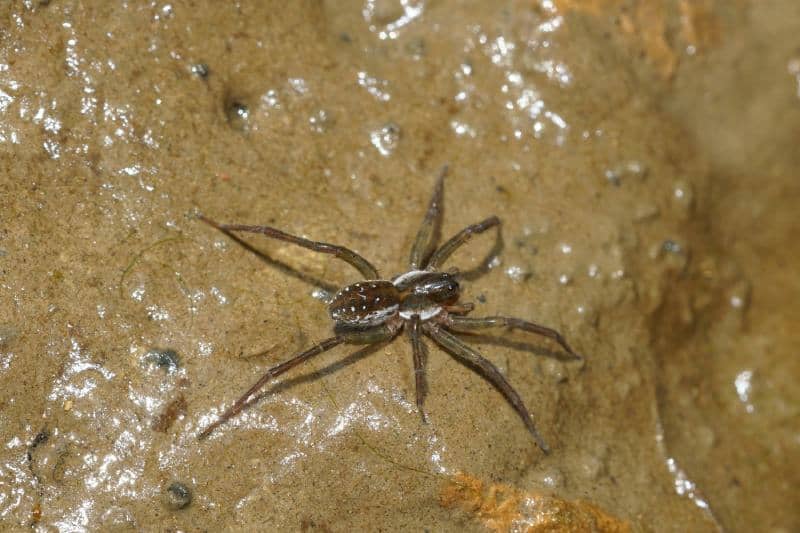
| Scientific Name: | Lycosidae |
| Risk: | Slightly venomous |
| Area: | Dark, damp areas |
Due to its size and toxicity, the wolf spider is one of the most feared arachnids in Ohio. These massive, furry creatures are the stuff of nightmares for any person with arachnophobia. They are insanely fast, and they love to rely on human-made structures to thrive.
If a wolf spider ever bites you, you can get very ill. However, these big guys would prefer not even being around humans and avoid you at all costs. These spiders are agile, efficient hunters with impeccable eyesight that will get rid of other pests around your home.
18. Woodlouse Hunter
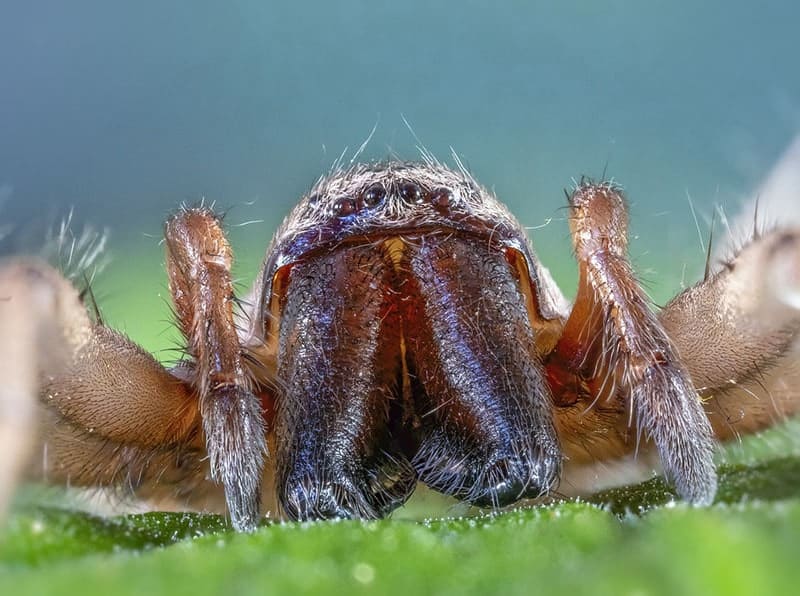
| Scientific Name: | Dydera crocata |
| Risk: | Mildly venomous |
| Area: | Wood, logs |
As the name suggests, the woodlouse hunter preys directly upon woodlice for nutritional staples. They are highly aggressive hunters—and aggressive breeders as well.
These brightly colored spiders might remind you a bit of fire ants, and their bite can be quite painful. Even though they won’t aggressively bite you, they might if they feel threatened.
19. Bowl & Doily Weaver
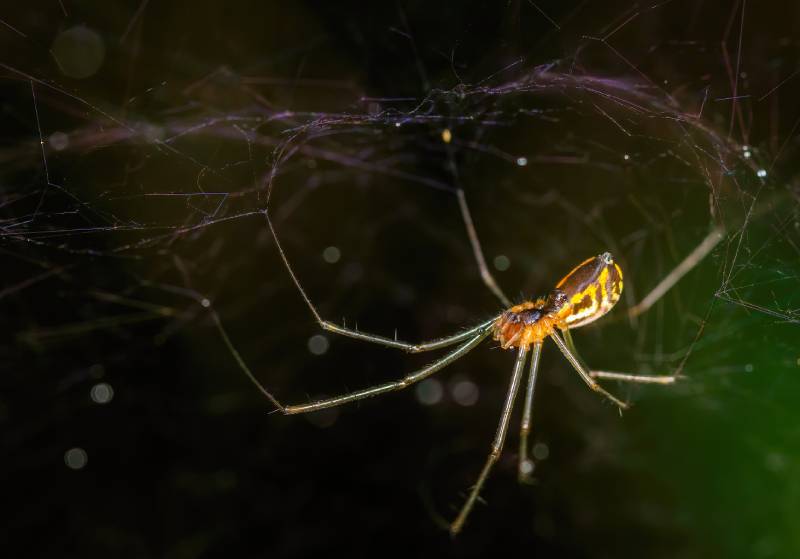
| Scientific Name: | Frontinella pyramitela |
| Risk: | Non-venomous |
| Area: | Corners, dark areas |
The bowl and doily weaver is a tiny spider that is part of the sheet-web family. It got its name due to the interesting bowl-shaped webs they create, perfectly designed to attract more prey. These spiders might be venomous to their victims, but they’re just too small to do real damage to humans.
These spiders can survive in many conditions, making them versatile and plentiful. But they spend most of their time in forests, shrubs, and humid areas, too.

Final Thoughts
Isn’t it extraordinary how such vastly different creatures can exist that are all the same thing by science terms? In such a small radius, these spiders show off fancy webbing, color, and hunting practices. Some may be perfectly harmless, but others you might have to watch out for.
Even though spiders might be scary sometimes, it’s best to learn risk factors. Once you realize just how innocent most Ohio spiders are, you can relax the next time you walk through the woods.
Featured Image Credit: Timelynx, Shutterstock
